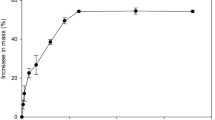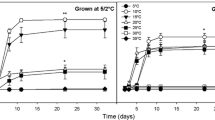Abstract
One of the most critical phases in the life cycle of plants encompasses early stages, since success in seed dormancy overcoming and germination as well as in seedling establishment represents a key process filtering the participation of species in plant communities. In this study, the requirements for dormancy breaking and germination of seeds of Helleborus foetidus were analyzed. The seeds were dormant with underdeveloped embryos (0.54 mm) at the time of dispersal and radicle emergence did not occur until embryos reached full size (3.6 mm). The light–temperature requirements for embryo growth and radicle emergence were studied correlating experiments under near-natural conditions with others under laboratory-controlled conditions. The embryos completed their growth and the radicle emerged when seeds were warm → cool stratified in darkness under a thermal sequence meeting late summer to early autumn temperature conditions. Conversely, cold stratified seeds did not germinate at winter temperatures (5 °C). The highest seed germination response (i.e., 75%) occurred in 6-month-old seeds incubated at 15/4 °C in darkness after being warm + cool stratified for 3 months (i.e., 32/18 °C for 1 month + 28/14 °C for 1 month + 25/10 °C for 1 month). In outdoor conditions, the embryo grew during late summer–autumn and the radicle emerged in late autumn, but the shoot did not emerge immediately because it was physiologically dormant too, so it required cold winter temperatures for dormancy breaking. Seedling establishment commenced at late winter–early spring, which is a more suitable season for seedling survival. In conclusion, the seeds of Helleborus foetidus exhibit deep simple epicotyl morphophysiological dormancy (MPD), which is ecologically well adapted to temperate forest regions. This is the second report of this level of MPD in Ranunculaceae.







Similar content being viewed by others
Data availability
The datasets analyzed during the current study are available from the corresponding author on reasonable request.
Code availability
Not applicable.
References
Adams CA, Baskin JM, Baskin CC (2003) Epicotyl dormancy in the mesic woodland herb Hexastylis heterophylla (Aristolochiaceae). J Torrey Bot Soc 130:11–15
Andersson L, Milberg P (1998) Variation in seed dormancy among mother plants, populations and years of seed collection. Seed Sci Res 8:29–38
Barton LV (1936) Germination and seedling production in Lilium sp. Contr Boyce Thompson Inst 8:297–309
Baskin JM, Baskin CC (1978) The seed bank in a population of an endemic plant species and its ecological significance. Biol Conserv 14:125–130
Baskin JM, Baskin CC (1990) Germination ecophysiology of seeds of the winter annual Chaerophyllum tainturieri: a new type of morphophysiological dormancy. J Ecol 78:993–1004
Baskin JM, Baskin CC (2004) A classification system for seed dormancy. Seed Sci Res 14:1–16
Baskin CC, Chien CT, Chen SY, Baskin JM (2008) Germination of Viburnum odoratissimum seeds: a new level of morphophysiological dormancy. Seed Sci Res 18:179–184
Baskin CC, Baskin JM (2014) Seeds. Ecology, biogeography and evolution of dormancy and germination. Academic Press, San Diego
Chevallier A (1996) The encyclopedia of medicinal plants. Dorling Kindersley, London
Chien CT, Chen SY, Chien TY, Baskin JM, Baskin CC (2011) Nondeep simple morphophysiological dormancy in seeds of Ilex maximowicziana from northern (subtropical) and southern (tropical) Taiwan. Ecol Restor 26:163–171
Copete E, Herranz JM, Ferrandis P, Baskin CC, Baskin JM (2011) Physiology, morphology and phenology of seed dormancy-break and germination in the endemic Iberian species Narcissus hispanicus (Amaryllidaceae). Ann Bot 107:1003–1016
Copete E, Herranz JM, Copete MA, Ferrandis P (2014) Interpopulation variability on embryo growth, seed dormancy break, and germination in the endangered Iberian daffodil Narcissus eugeniae (Amaryllidaceae). Plant Species Biol 29:e72–e84
Elías F, Ruiz L (1981) Estudio agroclimático de la región de Castilla-La Mancha. Junta de Comunidades de Castilla-La Mancha, Toledo
Eriksson O (1994) Seedling recruitment in the perennial herb Actaea spicata L. Flora 189:187–191
Fernández-Pascual E, Jiménez-Alfaro B (2014) Phenotypic plasticity in seed germination relates differentially to overwintering and flowering temperatures. Seed Sci Res 24:273–280
Fernández-Pascual E, Jiménez-Alfaro B, Caujapé-Castells J, Jaén-Molina R, Diaz TE (2013) A local dormancy cline is related to the seed maturation environment, population genetic composition and climate. Ann Bot 112:937–945
Gao R, Hou J, Zhao R, Yang X, Hou X, Huo L, Hidayati SN, Walck JL (2021) Seed dormancy and germination of a critically endangered plant, Elaeagnus mollis, on the Loess Plateau of China. Eur J Forest Res 140:451–461
Garrido JL, Rey PJ, Herrera CM (2007) Regional and local variation in seedling emergence mortality and recruitment of a perennial herb in Mediterranean mountain habitats. Plant Ecol 190:109–121
Herranz JM, Copete MA, Ferrandis P, Copete E (2010a) Intermediate complex morphophysiological dormancy in the endemic Iberian Aconitum napellus subsp. castellanum (Ranunculaceae). Seed Sci Res 20:109–121
Herranz JM, Ferrandis P, Martínez-Duro E (2010b) Seed germination ecology of the threatened endemic Iberian Delphinium fissum subsp. sordidum (Ranunculaceae). Plant Ecol 211:89–106
Herranz JM, Copete MA, Ferrandis P (2013) Environmental regulation of embryo growth, dormancy break and germination of Narcissus alcaracensis (Amaryllidaceae), a threatened endemic Iberian daffodil. Amer Midl Naturalist 169:147–167
Jankowska-Blaszczuk M, Daws MI (2007) Impact of red:far red ratios on germination of temperate forest herbs in relation to shade tolerance, seed mass and persistence in the soil. Funct Ecol 21:1055–1062
Kondo T, Okubo N, Miura T, Honda K, Ishiwaki Y (2002) Ecophysiology of seed germination in Erythronium japonicum (Liliaceae) with underdeveloped embryos. Am J Bot 89:1779–1784
Kondo T, Miura T, Okubu N, Shimada M, Baskin CC, Baskin JM (2004) Ecophysiology of deep simple epicotyl morphophysiological dormancy in seeds of Gagea lutea (Liliaceae). Seed Sci Res 14:371–378
Martin-Herrero J, Cirujano S, Moreno M, Peris JB, Stübing G (2003) La vegetación protegida en Castilla-La Mancha. Ed. Junta de Comunidades de Castilla-La Mancha. Toledo
Mattana E, Daws MI, Fenu G, Bacchetta G (2012) Adaptation to habitat in Aquilegia species endemic to Sardinia (Italy): seed dispersal, germination and persistence in the soil. Plant Biosyst 146:374–383
Meiners J, Winkelmann T (2012) Evaluation of reproductive barriers and realisation of interspecific hybridisations depending on genetic distances between species in the genus Helleborus. Plant Biol 14(4):576–585
Milberg P, Andersson L, Thompson K (2000) Large-seeded species are less dependent on light for germination than small-seeded. Seed Sci Res 10:99–104
Mira S, Arnal A, Pérez-García F (2017) Habitat-correlated seed germination and morphology in populations of Phillyrea angustifolia L. (Oleaceae). Seed Sci Res 27:50–60
Nikolaeva MG, Rasumova MV, Gladkova VN (1985) In: Danilova MF (eds) Reference book on dormant seed germination. “Nauka” Publishers, Leningrad Branch, Leningrad
Nomizu T, Niimi Y, Watawabe E (2004) Embryo development and seed germination of Hepatica nobilis Schreber var. japonica as affected by temperature after sowing. Sci Hortic 99:345–352
Pearson TRH, Burslem DFRP, Mullins CE, Dalling JW (2002) Germination ecology of neotropical pioneers: interacting effects of environmental conditions and seeds size. Ecology 83:2798–2807
Pérez-García F (1997) Germination of Cistus ladanifer seeds in relation to parent material. Plant Ecol 133:57–62
Pérez-García F, Hornero J, González-Benito ME (2003) Interpopulation variation in seed germination of five Mediterranean Labiatae shrubby species. Isr J Plant Sci 51:117–124
Platt RB (1951) An ecological study of the mid-Appalachian shale barrens and of the plants endemic to them. Ecol Monogr 21:269–300
Reed TE, Schindler DE, Waples RS (2011) Interacting effects of phenotypic plasticity and evolution on population persistence in a changing climate. Conserv Biol 25:56–63
Sánchez-Yelamo D, Ayerbe L (1984) Algunos aspectos de la ruptura de la dormición en semillas de helleboro fétido (Helleborus foetidus L). Anales del Instituto Nacional de Investigaciones Agrarias. Serie Agrícola 27:125–130
Stübing G, Peris JB (1998) Plantas Medicinales de la Comunidad Valenciana. Generalitat Valenciana. Consellería de Medio Ambiente
Thompson K, Grime JP (1979) Seasonal variation in the seed banks of herbaceous species in 10 contrasting habitats. J Ecol 67:893–921
Vandelook F, Van Assche JA (2008) Temperature requirements for seed germination and seedling development determine timing of seedling emergence of three monocotyledonous temperate forest spring geophytes. Ann Bot 102:865–875
Vandelook F, Lenaerts J, Van Assche JA (2009) The role of temperature in post-dispersal; embryo growth and dormancy break in seeds of Aconitum lycoctonum L. Flora 204:536–542
Vandelook F, Newton RJ, Carta A (2018) Photophobia in Lilioid monocots: photoinhibition of seed germination explained by seed traits, habitat adaptation and phylogenetia inertia. Ann Bot 121:405–413
Wagmann K, Hautekeete NC, Piquot Y, Meunier C, Schmitt SE, Vand Dijk H (2012) Seed dormancy distribution: explanatory ecological factors. Ann Bot 110:1205–1219
Walck JL, Baskin CC, Baskin JM (1999) Seeds of Thalictrum mirabile (Ranunculaceae) require cold stratification for loss of nondeep simple morphophysiological dormancy. Can J Bot 77:1769–1776
Walck JL, Baskin CC, Hidayati SN, Baskin JM (2008) Comparison of the seed germination of native and non-native winter annual Apiaceae in North America, with particular focus on Cyclospermum leptophyllum naturalized from South America. Plant Species Biol 23:33–42
Walck JL, Hidayati SN, Dixon KW, Poschold TK, P, (2011) Climate change and plant regeneration from seed. Glob Change Biol 17:2145–2161
Werner K, Ebel F (1994) Life-history of the genus Helleborus L. (Ranunculaceae). Flora 189:97–130
Williams ED (1983) Effects of temperature, light, nitrate and pre-chilling o seed germination of grassland plants. Ann Appl Biol 103:161–172
Acknowledgements
We do appreciate the Reviewers’ effort in checking the English throughout the entire manuscript.
Funding
E.C.’s salary is co-founded by FEDER (Fondos Europeos de Desarrollo Regional) funds.
Author information
Authors and Affiliations
Corresponding author
Ethics declarations
Conflict of interest
The authors have no conflicts of interest to the content of this article. The authors have no affiliations with or involvement in any organization or entity with any interest in the subject or materials discussed in this manuscript.
Ethics approval
Not applicable.
Consent to participate
Not applicable.
Consent for publication
All authors consent with the publication of this article.
Additional information
Communicated by A. Gniazdowska-Piekarska.
Publisher's Note
Springer Nature remains neutral with regard to jurisdictional claims in published maps and institutional affiliations.
Rights and permissions
Springer Nature or its licensor (e.g. a society or other partner) holds exclusive rights to this article under a publishing agreement with the author(s) or other rightsholder(s); author self-archiving of the accepted manuscript version of this article is solely governed by the terms of such publishing agreement and applicable law.
About this article
Cite this article
Ferrer, R.H., Carreño, M.A.C., Carreño, E.C. et al. Influence of environmental conditions on embryo growth, dormancy breaking, and germination in seeds of Helleborus foetidus (Ranunculaceae). Acta Physiol Plant 45, 137 (2023). https://doi.org/10.1007/s11738-023-03617-5
Received:
Revised:
Accepted:
Published:
DOI: https://doi.org/10.1007/s11738-023-03617-5




